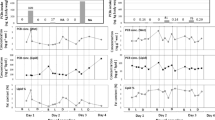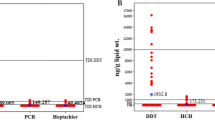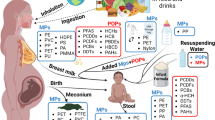Abstract
The present study is a stage of the regular POP monitoring conducted in the framework of the Russian Federation’s National Implementation Plan under the Stockholm Convention on Persistent Organic Pollutants. The POPs concentration (ΣHCH+ΣDDT+ΣPCB) in the samples ranged from 23 to 878 (with a mean of 151.4) ng/g lipid. The ranges of concentrations of OCPs (ΣHCH+ΣDDT) and PCBs were 2.8–291 and 3.2–720 ng/g lipid, respectively. The mean values of OCPs and PCBs amounted to 80.1 and 74.9 ng/g lipid, respectively. As suggested by the results of the EDI calculation, intake of PCBs is slightly high in infants. The fact that most studies have associated PCB with effects, such as development of congenital deformity, reduced immunity, lower weight, and small baby size at birth, makes it an alarming situation.



Similar content being viewed by others
References
Bányiová K, Černá M, Mikeš O, Komprdová K, Sharma A, Gyalpo T, Čupr P, Scheringer M (2017) Long-term time trends in human intake of POPs in the Czech Republic indicate a need for continuous monitoring. Environ Int 108:1–10. https://doi.org/10.1016/j.envint.2017.07.008
Bawa P, Bedi JS, Gill JPS, Aulakh RS, Kumar A, Arora K (2018) Persistent organic pollutants residues in human breast milk from Bathinda and Ludhiana districts of Punjab, India. Arch Environ Contam Toxicol 75:512–520. https://doi.org/10.1007/s00244-018-0512-3
Bedi JS, Gill JPS, Aulakh RS, Kaur P, Sharma A, Pooni PA (2013) Pesticide residues in human breast milk: risk assessment for infants from Punjab, India. Sci Total Environ 463–464:720–726. https://doi.org/10.1016/j.scitotenv.2013.06.066
Černá M, Spĕvácková V, Batáriová A et al (2007) Human biomonitoring system in the Czech Republic. Int J Hyg Environ Health 210:495–499. https://doi.org/10.1016/j.ijheh.2007.01.005
Černá M, Krsková A, Čejchanová M, Spěváčková V (2012) Human biomonitoring in the Czech Republic: an overview. Int J Hyg Environ Health 215:109–119. https://doi.org/10.1016/j.ijheh.2011.09.007
Chen M-W, Santos H, Que D et al (2018) Association between organochlorine pesticide levels in breast milk and their effects on female reproduction in a Taiwanese population. Int J Environ Res Public Health 15:931. https://doi.org/10.3390/ijerph15050931
Choi W, Kim S, Baek Y-W, Choi K, Lee K, Kim S, Yu SD, Choi K (2017) Exposure to environmental chemicals among Korean adults-updates from the second Korean National Environmental Health Survey (2012-2014). Int J Hyg Environ Health 220:29–35. https://doi.org/10.1016/j.ijheh.2016.10.002
Fujii Y, Ito Y, Harada KH, Hitomi T, Koizumi A, Haraguchi K (2012) Comparative survey of levels of chlorinated cyclodiene pesticides in breast milk from some cities of China, Korea and Japan. Chemosphere 89:452–457. https://doi.org/10.1016/j.chemosphere.2012.05.098
Grung M, Lin Y, Zhang H, Steen AO, Huang J, Zhang G, Larssen T (2015) Pesticide levels and environmental risk in aquatic environments in China - a review. Environ Int 81:87–97. https://doi.org/10.1016/j.envint.2015.04.013
Haraguchi K, Koizumi A, Inoue K, Harada KH, Hitomi T, Minata M, Tanabe M, Kato Y, Nishimura E, Yamamoto Y, Watanabe T, Takenaka K, Uehara S, Yang HR, Kim MY, Moon CS, Kim HS, Wang P, Liu A, Hung NN (2009) Levels and regional trends of persistent organochlorines and polybrominated diphenyl ethers in Asian breast milk demonstrate POPs signatures unique to individual countries. Environ Int 35:1072–1079. https://doi.org/10.1016/j.envint.2009.06.003
Jovanović G, Romanić SH, Stojić A, Klinčić D, Sarić MM, Letinić JG, Popović A (2019) Introducing of modeling techniques in the research of POPs in breast milk – a pilot study. Ecotoxicol Environ Saf 172:341–347. https://doi.org/10.1016/j.ecoenv.2019.01.087
Kim S, Eom S, Kim H-J, Lee JJ, Choi G, Choi S, Kim S, Kim SY, Cho G, Kim YD, Suh E, Kim SK, Kim S, Kim GH, Moon HB, Park J, Kim S, Choi K, Eun SH (2018) Association between maternal exposure to major phthalates, heavy metals, and persistent organic pollutants, and the neurodevelopmental performances of their children at 1 to 2 years of age- CHECK cohort study. Sci Total Environ 624:377–384. https://doi.org/10.1016/j.scitotenv.2017.12.058
Lenters V, Iszatt N, Forns J, Čechová E, Kočan A, Legler J, Leonards P, Stigum H, Eggesbø M (2019) Early-life exposure to persistent organic pollutants (OCPs, PBDEs, PCBs, PFASs) and attention-deficit/hyperactivity disorder: a multi-pollutant analysis of a Norwegian birth cohort. Environ Int 125:33–42. https://doi.org/10.1016/j.envint.2019.01.020
Li YF, Cai DJ, Singh A (1998) Technical Hexachlorocyclohexane use trends in China and their impact on the environment. Arch Environ Contam Toxicol 35:688–697. https://doi.org/10.1007/s002449900432
Lukyanova ON, Tsygankov VY, Boyarova MD, Khristoforova NK (2016) Bioaccumulation of HCHs and DDTs in organs of Pacific salmon (genus Oncorhynchus) from the Sea of Okhotsk and the Bering Sea. Chemosphere 157:174–180. https://doi.org/10.1016/j.chemosphere.2016.05.039
Lukyanova ON, Tsygankov VY, Boyarova MD (2018) Organochlorine pesticides and polychlorinated biphenyls in the Bering flounder (Hippoglossoides robustus) from the Sea of Okhotsk. Mar Pollut Bull 137:152–156. https://doi.org/10.1016/j.marpolbul.2018.10.017
Mamontova EA, Tarasova EN, Mamontov AA, Kuzmin MI, McLachlan M, Khomutova MIu (2007) The influence of soil contamination on the concentrations of PCBs in milk in Siberia. Chemosphere 67:S71–S78. https://doi.org/10.1016/j.chemosphere.2006.05.092
Mamontova EA, Tarasova EN, Mamontov AA (2017) PCBs and OCPs in human milk in eastern Siberia, Russia: levels, temporal trends and infant exposure assessment. Chemosphere 178:239–248. https://doi.org/10.1016/j.chemosphere.2017.03.058
Müller MHB, Polder A, Brynildsrud OB, Grønnestad R, Karimi M, Lie E, Manyilizu WB, Mdegela RH, Mokiti F, Murtadha M, Nonga HE, Skaare JU, Solhaug A, Lyche JL (2019) Prenatal exposure to persistent organic pollutants in Northern Tanzania and their distribution between breast milk, maternal blood, placenta and cord blood. Environ Res 170:433–442. https://doi.org/10.1016/j.envres.2018.12.026
Nicholson WJ, Landrigan PJ (1994) Human health effects of polychlorinated biphenyls. In: Schecter A (ed) Dioxins and health. Springer US, Boston, pp 487–524
Revich BA, Sergeyev OV, Shelepchikov AA (2012) Innovative environmental and epidemiologic technologies of assessment of dioxins impacts on children’s health. Hum Ecol (Russ Fed):42–49
Tsydenova OV, Sudaryanto A, Kajiwara N, Kunisue T, Batoev VB, Tanabe S (2007) Organohalogen compounds in human breast milk from Republic of Buryatia, Russia. Environ Pollut 146:225–232. https://doi.org/10.1016/j.envpol.2006.04.036
Tsygankov VY (2019) Organochlorine pesticides in marine ecosystems of the Far Eastern Seas of Russia (2000–2017). Water Res 161:43–53. https://doi.org/10.1016/j.watres.2019.05.103
Tsygankov VY, Boyarova MD (2015) Sample preparation method for the determination of organochlorine pesticides in aquatic organisms by gas chromatography. Achiev Life Sci 9:65–68. https://doi.org/10.1016/j.als.2015.05.010
Tsygankov VY, Boyarova MD, Kiku PF, Yarygina MV (2015) Hexachlorocyclohexane (HCH) in human blood in the south of the Russian Far East. Environ Sci Pollut Res 22:14379–14382. https://doi.org/10.1007/s11356-015-4951-3
Tsygankov VY, Boyarova MD, Lukyanova ON, Khristoforova NK (2017a) Bioindicators of organochlorine pesticides in the Sea of Okhotsk and the Western Bering Sea. Arch Environ Contam Toxicol 73:176–184. https://doi.org/10.1007/s00244-017-0380-2
Tsygankov VY, Khristoforova NK, Lukyanova ON, Boyarova MD, Kiku PF, Yarygina MV (2017b) Selected organochlorines in human blood and urine in the south of the Russian Far East. Bull Environ Contam Toxicol 99:460–464. https://doi.org/10.1007/s00128-017-2152-0
Tsygankov VY, Lukyanova ON, Boyarova MD (2018) Organochlorine pesticide accumulation in seabirds and marine mammals from the Northwest Pacific. Mar Pollut Bull 128:208–213. https://doi.org/10.1016/j.marpolbul.2018.01.027
Tsygankov VY, Yarygina MV, Lukyanova ON et al (2019) Trace concentrations of organochlorine compounds in biological liquids of the Russian far east residents. Ekologiya Cheloveka (Hum Ecol) 2019:15–19
Van Oostdam J, Gilman A, Dewailly E et al (1999) Human health implications of environmental contaminants in Arctic Canada: a review. Sci Total Environ 230:1–82. https://doi.org/10.1016/S0048-9697(99)00036-4
Wei D, Kameya T, Urano K (2007) Environmental management of pesticidal POPs in China: past, present and future. Environ Int 33:894–902. https://doi.org/10.1016/j.envint.2007.04.006
Yasmeen H, Qadir A, Mumtaz M, Eqani SAMAS, Syed JH, Mahmood A, Jamil N, Nazar F, Ali H, Ahmad MS, Tanveer ZI, Zhang G (2017) Risk profile and health vulnerability of female workers who pick cotton by organanochlorine pesticides from southern Punjab, Pakistan: health vulnerability of female workers who pick cotton. Environ Toxicol Chem 36:1193–1201. https://doi.org/10.1002/etc.3633
Funding
This work was supported by the Russian Science Foundation (agreement no. 18-14-00120).
Author information
Authors and Affiliations
Corresponding author
Additional information
Responsible editor: Philippe Garrigues
Publisher’s note
Springer Nature remains neutral with regard to jurisdictional claims in published maps and institutional affiliations.
Rights and permissions
About this article
Cite this article
Tsygankov, V.Y., Gumovskaya, Y.P., Gumovskiy, A.N. et al. Bioaccumulation of POPs in human breast milk from south of the Russian Far East and exposure risk to breastfed infants. Environ Sci Pollut Res 27, 5951–5957 (2020). https://doi.org/10.1007/s11356-019-07394-y
Received:
Accepted:
Published:
Issue Date:
DOI: https://doi.org/10.1007/s11356-019-07394-y




